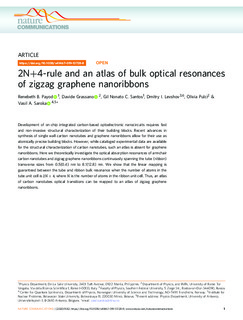| dc.contributor.author | Payod, R. B. | |
| dc.contributor.author | Grassano, D. | |
| dc.contributor.author | Santos, G. N. C. | |
| dc.contributor.author | Levshov, D. I. | |
| dc.contributor.author | Pulci, O. | |
| dc.contributor.author | Saroka, Vasil | |
| dc.date.accessioned | 2020-01-06T07:19:40Z | |
| dc.date.available | 2020-01-06T07:19:40Z | |
| dc.date.created | 2020-01-04T13:41:42Z | |
| dc.date.issued | 2020 | |
| dc.identifier.citation | Nature Communications. 2020, 11 (82) | nb_NO |
| dc.identifier.issn | 2041-1723 | |
| dc.identifier.uri | http://hdl.handle.net/11250/2634886 | |
| dc.description.abstract | Development of on-chip integrated carbon-based optoelectronic nanocircuits requires fast and non-invasive structural characterization of their building blocks. Recent advances in synthesis of single wall carbon nanotubes and graphene nanoribbons allow for their use as atomically precise building blocks. However, while cataloged experimental data are available for the structural characterization of carbon nanotubes, such an atlas is absent for graphene nanoribbons. Here we theoretically investigate the optical absorption resonances of armchair carbon nanotubes and zigzag graphene nanoribbons continuously spanning the tube (ribbon) transverse sizes from 0.5(0.4) nm to 8.1(12.8) nm. We show that the linear mapping is guaranteed between the tube and ribbon bulk resonance when the number of atoms in the tube unit cell is 2N+4, where N is the number of atoms in the ribbon unit cell. Thus, an atlas of carbon nanotubes optical transitions can be mapped to an atlas of zigzag graphene nanoribbons. | nb_NO |
| dc.language.iso | eng | nb_NO |
| dc.publisher | Nature Research | nb_NO |
| dc.relation.uri | https://rdcu.be/bZS5A | |
| dc.rights | Navngivelse 4.0 Internasjonal | * |
| dc.rights.uri | http://creativecommons.org/licenses/by/4.0/deed.no | * |
| dc.subject | Elektromagnetisme | nb_NO |
| dc.subject | Electromagnetism | nb_NO |
| dc.subject | Kvantefysikk | nb_NO |
| dc.subject | Quantum physics | nb_NO |
| dc.subject | Kvantekjemi | nb_NO |
| dc.subject | Quantum chemistry | nb_NO |
| dc.title | 2N+4-rule and an atlas of bulk optical resonances of zigzag graphene nanoribbons | nb_NO |
| dc.type | Journal article | nb_NO |
| dc.type | Peer reviewed | nb_NO |
| dc.description.version | publishedVersion | nb_NO |
| dc.subject.nsi | VDP::Kondenserte fasers fysikk: 436 | nb_NO |
| dc.subject.nsi | VDP::Condensed matter physics: 436 | nb_NO |
| dc.source.volume | 11 | nb_NO |
| dc.source.journal | Nature Communications | nb_NO |
| dc.source.issue | 82 | nb_NO |
| dc.identifier.doi | 10.1038/s41467-019-13728-8 | |
| dc.identifier.cristin | 1766240 | |
| dc.relation.project | EC/H2020/644076 | nb_NO |
| dc.relation.project | Norges forskningsråd: 262633 | nb_NO |
| dc.description.localcode | Open Access This article is licensed under a Creative Commons Attribution 4.0 International License, which permits use, sharing, adaptation, distribution and reproduction in any medium or format, as long as you give appropriate credit to the original author(s) and the source, provide a link to the Creative Commons license, and indicate if changes were made. The images or other third party material in this article are included in the article’s Creative Commons license, unless indicated otherwise in a credit line to the material. If material is not included in the article’s Creative Commons license and your intended use is not permitted by statutory regulation or exceeds the permitted use, you will need to obtain permission directly from the copyright holder. To view a copy of this license, visit http://creativecommons.org/licenses/by/4.0/. | nb_NO |
| cristin.unitcode | 194,66,20,0 | |
| cristin.unitname | Institutt for fysikk | |
| cristin.ispublished | true | |
| cristin.fulltext | original | |
| cristin.qualitycode | 2 | |

